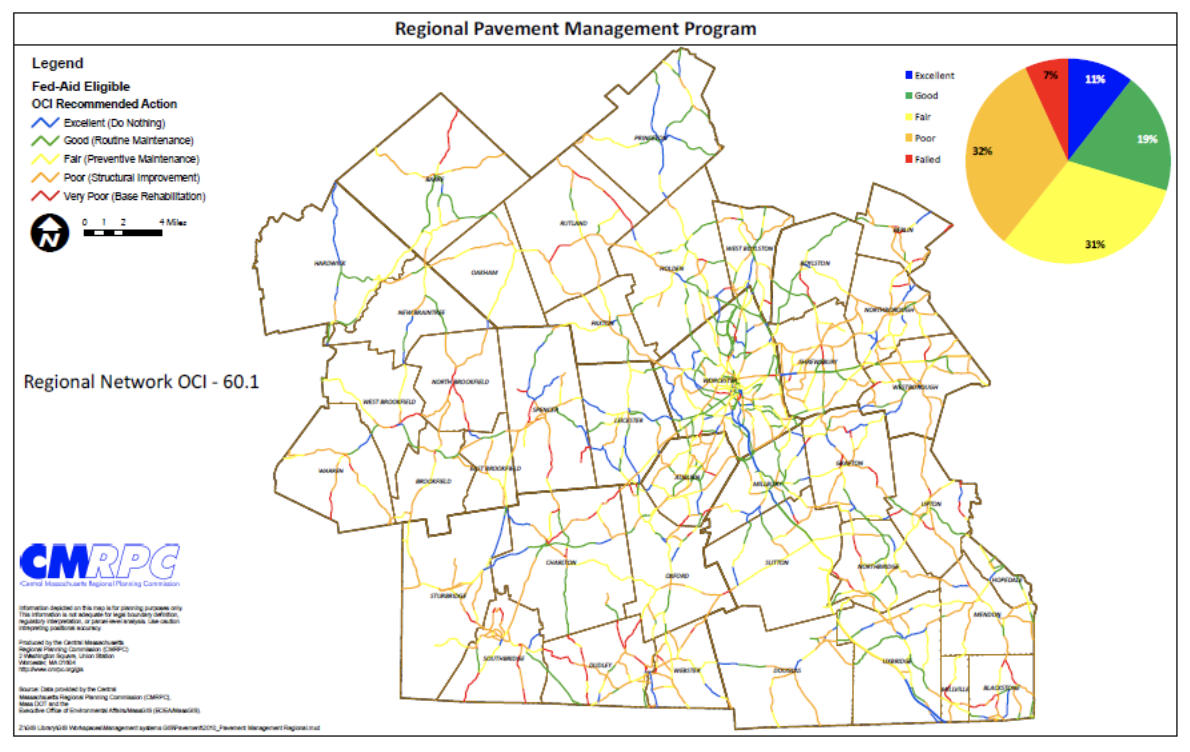3.2: Manual Inspection and Condition Assessment of Infrastructure
- Page ID
- 21118
Manual inspection and condition assessment of infrastructure components is a common practice. These inspections require a knowledgeable individual and can include visual inspection, hearing (for motor sounds for example) and touch.
Good manual inspections have a defined rubric and a focus on completeness and consistency of condition assessment. A rubric is a guide for condition assessment based upon a set of rules or text descriptions. A wide variety of rubrics for infrastructure components exists. Figure 3.2 summarizes a rubric for pavement condition assessment as an example. In addition to this pavement condition assessment, other considerations for conditions might be skid resistance and structural capacity. Chapter 2, presents the results of a series of roof inspections with indices for roof components and an overall condition assessment.
- 4.0 – 5.0: Only new (or nearly new) superior pavements are likely to be smooth enough and distress free (sufficiently free of cracks and patches) to qualify for this category. Most pavements constructed or resurfaced during the data year would normally be rated in this category.
- 3.0 – 4.0: Pavements in this category, although not quite as smooth as those described above, give a first class ride and exhibit few, if any, visible signs of surface deterioration. Flexible pavements may be beginning to show evidence of rutting and fine random cracks. Rigid pavements may be beginning to show evidence of slight surface deterioration, such as minor cracks and spalling.
- 2.0 – 3.0: The riding qualities of pavements in this category are noticeably inferior to those of new pavements, and may be barely tolerable for high-speed traffic. Surface defects of flexible pavements may include rutting, map cracking, and extensive patching. Rigid pavements in this group may have a few joint failures, faulting and/or cracking, and some pumping.
- 1.0 – 2.0: Pavements in this category have deteriorated to such an extent that they affect the speed of free-flow traffic. Flexible pavement may have large potholes and deep cracks. Distress includes raveling, cracking, rutting and occurs over 50 percent of the surface. Rigid pavement distress includes joint spalling, patching, cracking, scaling, and may include pumping and faulting.
- 0.1 – 1.0: Pavements in this category are in an extremely deteriorated condition. The facility is passable only at reduced speeds, and with considerable ride discomfort. Large potholes and deep cracks exist. Distress occurs over 75 percent or more of the surface.
Figure 3.2 - Pavement Serviceability Index Rubric. Source: FHWA, ‘Present Serviceability Rating’, Public Domain, http://safety.fhwa.dot.gov/tools/dat...ereport/29.cfm.
Manual inspectors usually compare and discuss their results as a means of inculcating consistency and accuracy in condition assessments. For some types of inspections, formal classes and certifications may be required, such as the certification required for roadway bridge inspections.
Numerical indexes for condition assessment are also common, as with the .1 to 5.0 scale shown in Figure 3.2. Integer indexes are the most common for manual inspections. However, there is no consistency in the range of defined ratings among different infrastructure systems: inspectors may employ 0 to 3, 1 to 5, 1 to 10 and others. The best ratings also differ, with some systems having higher numbers for better conditions (as in Figure 3.2) and some indexes having lower numbers for better conditions.
Through the application of various manual rating systems condition indices, the following general guidelines emerge with respect to condition indices: it is difficult to differentiate between more than 7 condition states; a condition state of zero (0) may cause difficulties in derivative calculations; rating systems that equate a higher value with a better condition tend to graph more intuitively. Regardless, users of condition indexes should always check the index definitions to avoid misinterpretation of conditions!
Numerical condition indexes are often used in deterioration models as discussed in Chapter 3. They are also useful for developing comparisons and metrics of overall infrastructure conditions. For example, Figure 3.3 shows a map of pavement conditions in a region of central Massachusetts.

Figure 3.3 - Example Display of Pavement Conditions. Source: Central Massachusetts Regional Planning Commission, Public Domain, ‘Pavement Management,’ www.cmrpc.org/transportation-data-and-map.
While condition assessments are usually numerical, they may also take the form of a condition grade, such as the scale A – excellent; B – very good; C – good; D – passable and F – failing.
Infrastructure ‘grades’ are also regularly prepared, but they generally involve a broader range of considerations than a simple condition assessment. These grades might include functional compliance with particular goals, adequacy of capacity relative to demand, infrastructure resilience and other considerations as well as the infrastructure condition. As an example, the criteria used in assigning infrastructure grades by the American Society of Civil Engineers (2016) includes condition rating but a variety of other criteria:
- Capacity – Evaluate the infrastructure’s capacity to meet current and future demands.
- Condition – Evaluate the infrastructure’s existing or near-future physical condition.
- Funding – Evaluate the current level of funding (from all levels of government) for the infrastructure category and compare it to the estimated funding need.
- Future Need – Evaluate the cost to improve the infrastructure and determine if future funding prospects will be able to meet the need.
- Operation and Maintenance – Evaluate the owners’ ability to operate and maintain the infrastructure properly and determine that the infrastructure is in compliance with government regulations.
- Public Safety – Evaluate to what extent the public’s safety is jeopardized by the condition of the infrastructure and what the consequences of failure may be.
- Resilience – Evaluate the infrastructure system’s capability to prevent or protect
against significant multi-hazard threats and incidents and the ability to expeditiously recover and reconstitute critical services with minimum damage to public safety and health, the economy, and national security.
- Innovation – Evaluate the implementation and strategic use of innovative techniques and delivery methods.


